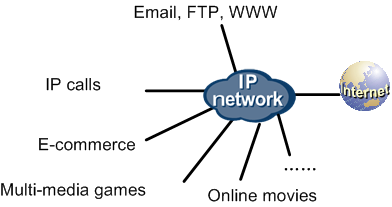QoS Overview
This chapter describes what the quality of service (QoS) is and introduces some QoS solutions, such as RSVP and DiffServ Model.
What Is QoS
Quality of service (QoS) is a mechanism that provides end-to-end service quality assurance to meet different requirements of various services. It allows different traffic to compete for network resources based on their priorities, thereby using existing resources more effectively instead of increasing network bandwidth. In this way, voice, video, and important data applications can be preferentially processed on network devices.

Diversified services enrich users' lives but also increase the risk of traffic congestion on the Internet. In the case of traffic congestion, services can encounter long delays or even packet loss. As a result, services deteriorate or even become unavailable. Therefore, a solution to resolve traffic congestion on the IP network is urgently needed.
The best way to resolve traffic congestion is actually to increase network bandwidths. However, increasing network bandwidths is not practical in terms of operation and maintenance costs.
This has subsequently led to the development of QoS technology. QoS has played an overwhelmingly important role on the Internet. Without QoS, service quality cannot be guaranteed.
Four Components in the DiffServ Model
Classification and Marking: classification classifies packets while keeping the packets unchanged. Traffic marking sets different priorities for packets and therefore changes the packets.

Traffic marking refers to external re-marking, which is implemented on outgoing packets. Re-marking modifies the priority field of packets to relay QoS information to the next-hop device.
Internal marking is used for internal processing and does not modify packets. Internal marking is implemented on incoming packets for the device to process the packets based on the marks before forwarding them. The concept of internal marking is discussed later in this document.
Policing and Shaping: restricts the traffic rate to a specific value. When traffic exceeds the specified rate, traffic policing drops excess traffic, and traffic shaping buffers excess traffic.
Congestion management: places packets in queues for buffering when traffic congestion occurs and determines the forwarding order based on a specific scheduling algorithm.
Congestion avoidance: monitors network resources. When network congestion intensifies, the device proactively drops packets to regulate traffic so that the network is not overloaded.

